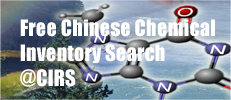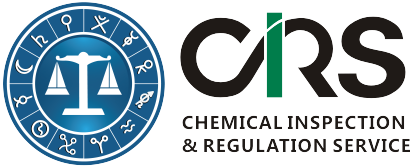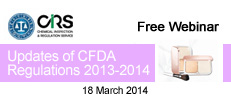
Registration of New Cosmetic Ingredient with SFDA in China
by Yunbo Shi, Managing Director - Regulatory Affairs, March 2012
According to the article 9 of the regulations concerning the hygiene supervision over cosmetics (1990), new cosmetic ingredient to be used for cosmetics production in China must be approved by Chinese authorities first[1]. However, it can be very difficult and time-consuming to get new cosmetic ingredients approved in China. Only 8 new cosmetics ingredients have been approved since 2004 based on CIRS’s statistics. Companies may also have trouble with the determination criteria for a new ingredient, mandatory animal testing and risk assessment for the registration of new cosmetic ingredient in China.
In this article, we have summarized the latest requirements for the registration of new cosmetic ingredient in China.
What is New!
23 Jan 2014, CFDA consults on a consolidated list of IECIC. There are 8641 existing cosmetic ingredients. More info can be found here.
24 Jan 2014, CFDA has published a notice to invite public comments on
the amendment of new cosmetic ingredient registration management
rules. The new rules give new cosmetic ingredient registrants a protection period of 4 years. More info can be found here.
Determination of Whether an Ingredient Is New or Not?
In China, a new cosmetic ingredient is defined as any natural or artificial cosmetic ingredient that is used in cosmetics in China for the first time [1]. An ingredient is not new if it meets the following criteria:
- The ingredient has been used in cosmetics in China before; and
- Safety assessment has been carried out for the ingredient.
An ingredient will be regarded as “used” if it meets any one of the three following criteria.
- The ingredient is included in the Inventory of Existing Cosmetic Ingredients in China (IECIC 2003) and is not a banned substance; or
- The ingredient has been used in a licensed special use cosmetic product; or
- The ingredient is part of a plant that has been approved as cosmetic ingredient.
It shall be noted that the following criteria are not sufficient to prove that one ingredient has been assessed or the ingredient is an existing ingredient.
- The ingredient is included in INCI directory; or
- The ingredient has been used in a licensed ordinary use cosmetic product; or
- The ingredient has a history of safe use as food ingredient.
For a long time, the State Food and Drug Administration (SFDA) has relied on the IECIC 2003, an internally circulated list of cosmetics ingredients, in determining whether an ingredient is new. This has caused lots of trouble within the industry. Therefore, to strengthen the safety management of cosmetic ingredients and make determination criteria more transparent, the CFDA has issued a revised version of IECIC in three batches for consulations in 2012 and has finalized two batches in 2013. More info about the revised IECIC can be found here.
Note: If a new cosmetic ingredient is not listed on Inventory of Existing Chemical Substances Produced or Imported in China (IECSC), it must be registered with CRC of MEP. More info can be found here.
Registration of New Cosmetic Ingredient
If an ingredient is new, it must be registered with the SFDA prior to being used in cosmetics in China. If a new cosmetic ingredient is to be imported into China on its own or in finished cosmetic products, the manufacturer of the new ingredient or finished cosmetic products must register the new ingredient with the Chinese SFDA [3]. Usually, a Chinese responsible agent needs to be appointed for the registration work.
The following documents are required for the registration of a new cosmetic ingredient in China according to the guidelines for the registration and technical review of new cosmetic ingredients published in 2011[4].
- Application form for hygiene license for new cosmetic ingredient;
- A research & development report consisting of the following information:
- Background of research, R&D process and relevant technical files;
- The source of ingredient, physiochemical properties, molecular structure, molecular structure, molecular weight;
- Purpose in cosmetics, supporting proof, scope and extent of use in cosmetics;
- Brief description and diagram of production process;
- Standards for quality and safety control of ingredient (including qualitative and quantitative test methods and specifications for the ingredient and impurities, etc);
- Toxicology safety assessment data including safety assessment of risk substances;
- Power of Attorney in case of using an agent;
- Other information which are helpful to review;
Since 2008, CFDA has only approved 4 new cosmetic ingredients and they are:
Ingredient Name |
Type of Applicant |
Date of Comment Letter |
Date of Approval |
Origin |
POLYMETHACRYLOYL LYSINE |
Foreign |
15/6/2011 |
19/3/2012 |
Synthesis derived ( polymer) |
Dimethoxytolyl Propylresorcinol |
Foreign |
15/6/2011 |
19/3/2012 |
Synthesis derived(derivative of resorcinol) |
Phenylethyl Resorcinol |
Foreign |
7/8/2012 |
5/12/2012 |
Synthesis derived(derivative of resorcinol) |
Elaeagnus mollis diel Oil |
Domestic |
28/6/2013 |
- |
Plant derived |
Required Toxicology Data and Exemptions
In general, the following toxicology data is required [3]. The source of data could be from testing reports, public literature, data published by domestic and overseas government or international organizations. If test report is conducted in overseas labs (GCP or GLP is preferred), original full study report or certified copy is required [6].
- acute oral and acute dermal toxicity;
- skin and eye irritation/corrosion;
- skin sensitisation;
- skin phototoxicity and photosensitivity (required if the ingredient is used as UV-filters);
- mutagenicity (should at least include a gene mutation test and a chromosome aberration test);
- sub-chronic oral and dermal toxicity;
- teratogenicity;
- chronic toxicity/carcinogenicity;
- toxicokinetics and dynamics;
Some data endpoints listed above can be exempt based on the properties and use of the new ingredient. For example, if the new ingredient is structurally similar to an existing ingredient and shares the similar property with the existing ingredient, some tests can be waived. More exemptions are listed in the following table.
Exemption Criteria |
Exempt endpoints |
|---|---|
(1)The ingredient is not used as a preservative, sun block agent, colorant or hair dye; and |
7, 8, 9, sub-chronic oral or dermal toxicity depending on exposure route |
(3)The ingredient has met criteria (1)+(2) and the ingredient has been included the inventory of existing ingredients in overseas authoritative organization for more than 4 years; and |
6,7,8,9 |
(5) The ingredient is proven to have a history of safe use as food ingredient by government or authoritative organizations. |
1,5,6,7,8,9 |
(6)Polymer with average molecular weight above 1000 Daltons; |
1,3,5,6,7,8,9 and photosensitivity |
(7)Risk assessment of the cosmetic has been carried out by overseas authoritative organizations and the conclusion is that the ingredient is safe to be used in cosmetics. |
1,2,3,4,5,6,7,8,9 |
Usually, if a new ingredient meets criteria 5, 6 or 7, it will be easier and less expensive to get approved in China.
Use of Alternatives to Animal Testing
China SFDA requires animal toxicology test reports to be provided prior to licensing a new cosmetic ingredient. Many international companies have complained about this as US and European countries have banned unnecessary animal testing for cosmetics. China has realized that this is going to be a burden for international trade and has started recognizing test results that use alternatives to animal testing. On 10 Feb 2012, China SFDA has proposed first in vitro method for cosmetic phototoxicity [5]. We expect to see more alternative methods to animal testing accepted by Chinese authorities.
In cases where animal testing is mandatory and no alternative method is available for getting a new ingredient approved in China, companies who cannot conduct those studies themselves due to company policies might try to ask third parties in China to conduct those studies and refer to those studies during the submission of toxicology data.
Safety Assessment of Ingredient and Risk Substances
When registering a new cosmetic ingredient, safety assessment of the ingredient and risk substances is crucial [4,6]. China SFDA has shifted the responsibilities of risk assessment from government to registrants. Risk substances are the components (impurities or additives) that may cause potential harm to human health resulted from raw materials or brought in during the production process.
Toxicology safety assessment data required by China SFDA usually consists of three parts: safety assessment report of the ingredient, necessary toxicology test reports and the safety assessment of risk substances in the ingredient. If there are no risk substances in the ingredient, a letter of commitment shall be provided.
The required safety assessment report shall include the following contents:
- Ingredient characterization through relevant physico-chemical data, purity and profile of impurities or additives ;
- Source of the ingredient(like synthesis, animal source or plant extract);
- Data on pesticide residues and other impurities brought in during the extraction process in case of ingredient extracted from plant;
- Toxicological profiles of the ingredient and risk substances(including whether a substance has been regarded as a carcinogen by IRAC);
- Summary of the restriction of risk substances in cosmetic ingredient, finished cosmetics, food, air, water(if available) found in public literature or international regulations;
- The concentration of risk substances in the ingredient and finished cosmetics, qualitative and quantitative testing methods and relevant public literature;
- Hazard characterization, dose-response assessment(calculation of NOAEL if appropriate) and exposure assessment;
- Calculation of safety or exposure margins (as appropriate) for the ingredient and risk substances;
The new guidelines for risk assessment of cosmetic ingredient and cosmetics are consistent with those used in EU and US. If one ingredient has been assessed by international authoritative organizations and has been proved to be safe, China does not require toxicology studies any more. However, risk assessment report, conclusions, approval document and relevant documents need to be provided.
Administrative Procedure for the Approval of New Ingredient
It takes 5 days for SFDA to issue an acceptance notice since all required documents have been submitted, 90 working days for SFDA to conduct the technical review of the new ingredient and 20 days to issue an approval notice or an opinion letter to the registrant to request more documents.
Main Issues
It can be very difficult to register a new cosmetic ingredient in China. Some of the main issues are listed as below:
- Pre-test sample validation;
- Identification of analytical methods for ingredient and impurities. Such methods might need to be validated;
- Identification of risk substances and risk assessment;
- Lack of alternative methods;
- Original or certified copies of test reports;
- Identification of monomer residue in polymers.
As guidelines have been published, we expect to see more new ingredients to get approved in the future.
References
[1]. Regulations concerning the hygiene supervision over cosmetics(1990)
化妆品卫生监督条例
http://www.gov.cn/banshi/2005-08/01/content_19081.htm
[2]The first batch of Inventory of Existing Cosmetics Ingredients (IECIC 2011)- draft
关于征求《已使用化妆品原料名称目录(第一批)》(征求意见稿)意见的函
http://www.sda.gov.cn/WS01/CL0530/67480.html
[2-2]China SFDA consults on the revised draft of the first batch of IECIC(2012)
关于再次征求《已使用化妆品原料名称目录(第一批)》(征求意见稿)意见的函
http://www.sda.gov.cn/WS01/CL0781/71242.html
[3]Rules for the application of administrative licenses for cosmetics (including new ingredient)(2009)
关于印发化妆品行政许可申报受理规定的通知
http://www.sda.gov.cn/WS01/CL0060/44671.html
[4]Guidelines for the registration and evaluation of new cosmetic ingredient (2011).
关于印发化妆品新原料申报与审评指南的通知
http://www.sda.gov.cn/WS01/CL0846/61608.html
[5]China SFDA consults first in vitro method for cosmetic phototoxicity(2012)
关于征求《化妆品用化学原料体外3T3中性红摄取光毒性试验方法(征求意见稿)》意见的函
http://www.sda.gov.cn/WS01/CL0781/68975.html
[6]Guidelines for the safety assessment for risk substances in cosmetics(2010)
关于印发化妆品中可能存在的安全性风险物质风险评估指南的通知
http://www.sda.gov.cn/WS01/CL0055/52911.html
[7]More rules to standardize the applications of administrative licenses for cosmetics and new cosmetic ingredient (2011)-draft
关于征求进一步规范化妆品及新原料行政许可有关事项意见的函
http://www.sda.gov.cn/WS01/CL0027/66536.html
About the Author
Mr Yunbo Shi is currently the managing director of CIRS, a leading provider of comprehensive chemical compliance services for companies doing businesses in/with EU and China with a strong focus on chemical compliance. He specializes in chemical classification, GHS, risk assessment, chemical product registration and consumer products labeling review.
Mr Yunbo Shi earned a B.S. in Chemistry from University of Science and Technology of China (USTC) and a Master’s Degree in Chemistry from University of Maryland, College Park.
- CIRS China
11F Building 1, Dongguan Hi-Tech Park, 1288 Chunbo Road, Binjiang District, Hangzhou 310052, China
Tel: +86-571 8720 6555 | Fax: +86-571 8720 6533
Email: service@cirs-reach.com

Related
- Download Full Report on SFDA Registration of New Cosmetic Ingredient in China[351KB, pdf]
- Inventory of Existing Cosmetics Ingredients China (IECIC 2012)- First Batch
- Inventory of Existing Cosmetics Ingredients China (IECIC 2012)- Second Batch
- SFDA Registration of Cosmetics in China
- New Chemical Substance Notification in China

_will_be_held_in_Shanghai.jpg)
